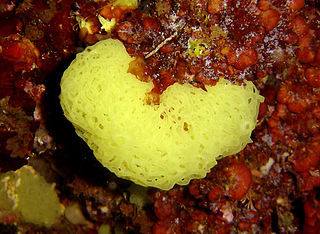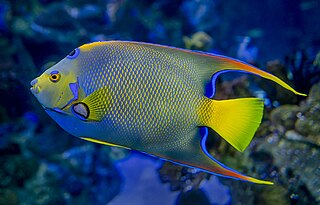
Ilha da Queimada Grande, also known as Snake Island, is an island off the coast of Brazil in the Atlantic Ocean. It is administered as part of the municipality of Itanhaém in the State of São Paulo. The island is small in size, only 43 hectares, and has a temperate climate. The island's terrain varies considerably, ranging from bare rock to rainforest.

Clathrina is a genus of calcareous sponge in the family Clathrinidae. Several species formerly in Clathrina were transferred to the newly erected genera Arturia, Ernstia, Borojevia, and Brattegardia in 2013. The name is derived from the Latin word "clathratus" meaning "latticed".

The queen angelfish, also known as the blue angelfish, golden angelfish or yellow angelfish, is a species of marine angelfish found in the western Atlantic Ocean. It is a benthic warm-water species that lives in coral reefs. It is recognized by its blue and yellow coloration and a distinctive spot or "crown" on its forehead. This crown distinguishes it from the closely related and similar looking Bermuda blue angelfish, with which it overlaps in range and can interbreed.

Plakinidae is a family of marine sponges. It is composed of seven genera:

Arturia is a genus of calcareous sponge in the family Clathrinidae which contains 14 species. It is named after Arthur Dendy, a prominent researcher of calcareous sponges. It was renamed Arturia in 2017 because the name Arthuria was already assigned to a genus of molluscs.
Borojevia is a genus of calcareous sponge in the family Clathrinidae. The genus is named after sponge researcher Radovan Borojevic.

Ernstia is a genus of calcareous sponges in the family Clathrinidae. The genus was erected in 2013 to contain five species previously assigned to Clathrina. The genus name honors German naturalist Ernst Haeckel for his contributions towards sponge taxonomy and phylogeny.
Plakortis edwardsi is a species of sea sponge in the order Homosclerophorida, first found in vertical walls of reef caves at depths of about 23 to 28 metres in the Caribbean Sea. This species has diods of a single category, with thick and S-shaped centres ; triods which are T-shaped. It is the only species of this genus exhibiting small diods.
Plakortis myrae is a species of sea sponge in the order Homosclerophorida, first found in vertical walls of reef caves at depths of about 23 to 28 metres in the Caribbean Sea. This species has diods of two categories: large ones which are abundant, and rare small ones with S-shaped centres; triods which are Y- or T-shaped, and possesses abundant microrhabds.
Plakina nathaliae is a species of sea sponge in the order Homosclerophorida, first found in vertical walls of reef caves at depths of about 23 to 28 metres in the Caribbean Sea. It has a leaf-like flat body, which is loosely attached to the substrate and a perforated, unlobate surface; it contains two bacterial morphotypes and is characterized by two mesohylar cell types with inclusions.
Tethya rubra is a species of sea sponge belonging to the family Tethyidae. It is found in the Atlantic Ocean off the coast of Brazil.
Octopus insularis is a species of octopus described in 2008 from individuals found off the coast of Brazil, with a potentially much larger range.

Plakortis is a genus of marine sponges in the order Homosclerophorida, first described by Franz Eilhard Schulze in 1880.
Plakortis bergquistae is a species of marine sponge in the order Homosclerophorida, first described in 2011 by Guilherme Muricy. The species epithet, bergquistae, honours Patricia Bergquist.
Plakortis communis is a species of marine sponge in the order Homosclerophorida, first described in 2011 by Guilherme Muricy.
Guilherme Muricy is a Brazilian invertebrate zoologist, and Professor of Invertebrate Zoology at the National Museum of Brazil. He is a specialist in sponges and has written over 100 papers on the chemistry, the taxonomy of sponges, and the descriptions of many new sponge species.
Plakortis fromontae is a species of marine sponge in the order Homosclerophorida, first described in 2011 by Guilherme Muricy. The species epithet, fromontae, honours Jane Fromont.
Plakortis hooperi is a species of marine sponge in the order Homosclerophorida, first described in 2011 by Guilherme Muricy. The species epithet, hooperi, honours John Hooper, an Australian sponge specialist.
Plakortis microrhabdifera is a species of marine sponge in the order Homosclerophorida, first described in 2003 by Moraes and Guilherme Muricy, from specimens collected from oceanic islands off north-eastern Brazil.
Corticium furcatum is a species of sponge in the order Homosclerophorida. It was first described in 2021, from a fragmented specimen collected at a depth of 5-7 m on the Booker Rocks in Jurien Bay.





